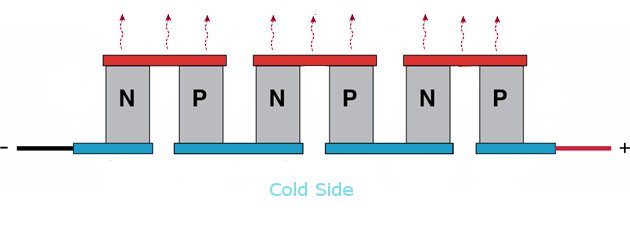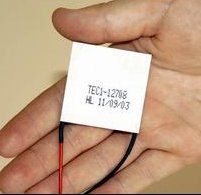Peltier Elements Make Heat Cold Or Electricity
Quick Summary: A Peltier element is a simple tool that has no moving parts and can be used to heat or cool or generate electricity. The great versatility makes these devices quite useful for a long term survival situation. They have limitations in that they aren't very efficient and don't do a whole lot of work individually but that is countered by their simplicity.
Peltier elements are solid state devices which means they will last a very long time. They are flexible in that they can be used to do things such as but not limited to, charging batteries, running small electrical devices such as LEDs, as well as heating and cooling.
You are only limited by your imagination and the number of these Peltier elements that you have available. I would love to have thousands of these with me when the SHTF.
OK now a little more information on how these Peltier elements work. The Peltier effect was discovered by, who else, a man named Peltier in the early 19th century. The Peltier effect occurs whenever electrical current flows through two dissimilar conductors. The flow of electricity causes one side to get hot and the other to get cold. The degree of heating or cooling that you get is determined in large part by the type of metal that is used. Bismuth Telluride is a very commonly used Peltier element metal.
You can use any metal but you will be wasting your time if the best metal isn't used. For example if lead is used the effect is there but so small that you will not even be able to measure it. So for the time being don't even consider making one of these yourself.
Here is why! While you can make a simple thermoelectric device with a single semiconductor pellet, you can't move a significant amount of heat through it as each pellet can only handle very small voltage (millivolts). In order to give a Peltier device greater ability you need multiple pellets of two different metals used together. Different elements work better for heating or cooling so two different metals are used alternating between the two.
This is usually company proprietary information.
See the figure below for how a real Peltier element is arranged.

Thus the most common Peltier devices now use this format connecting more than a couple of hundred of the pellets and this allows for the device to still only draw for example 5 amps, instead of more than a thousand had each been wired in parallel. Most are designed to run on systems of 12 to 16 Volts. Always DC current! Never AC as AC would simply run the current back and forward through the device producing nothing but waste heat.
So, you take this one small device and with some electricity both heat and cool the device on opposite sides OR you can add heat like from a flame to one side and cool the other side and produce small amounts of electricity.
If you are running electricity through a Peltier device and want the reverse the hot side and the cold side you simply reverse the direction of electricity by swapping the leads.
Usually a heat sink is going to be connected to each side of the Peltier device to move heat from the cold side through the hot side faster. Faster movement of heat means more electricity is produced. If the heat isn't removed from the hot side the device is going to stop working So heat sinks are very important to getting anything useful from these devices.
WARNING: When adding heat to the system the device can only handle a certain temperature. If you exceed that temp the device will melt and fail permanently. 150 degrees Celsius is a very common temperature limit. Remember 100 degree C is 212 degrees F.
Build your own Thermoelectric Fan!
Common uses for these devices that you might be familiar with are the 12 volt portable coolers, or the drink coolers that keep your can of soda cold. Many computers use these devices to keep the CPU cool. They would be mounted between the CPU and the heat sink. Not all computers use them though. The older the computer the less likely it is to have one. There are a number of industrial uses for these as well such as in some lasers.
A quick recap. Apply DC electricity to these devices and they will cool one side and heat the other side of the device. Also if you apply a difference in temperature across the device you can generate electricity! Pretty cool huh!
Note: Power generation is called the Seebeck effect... same device just a different use.
This is what they typically look like!

Ideas on what SHTF applications you can use these for.
1. Charge your cell phone battery! Sure no ability to make calls but lots of useful apps could come in handy.
2. Cool a drink.
3. Make small amounts of ice even.
4. Run electrical devices using fire (wood/candle/wind/solar etc) as the power source to heat the Peltier device. Refrigeration anyone!
5. Use a wind turbine to generate electricity or use generated electricity to run a DC fan!
Back To Survival Electricity Menu
Peltier elements are solid state devices which means they will last a very long time. They are flexible in that they can be used to do things such as but not limited to, charging batteries, running small electrical devices such as LEDs, as well as heating and cooling.
You are only limited by your imagination and the number of these Peltier elements that you have available. I would love to have thousands of these with me when the SHTF.
OK now a little more information on how these Peltier elements work. The Peltier effect was discovered by, who else, a man named Peltier in the early 19th century. The Peltier effect occurs whenever electrical current flows through two dissimilar conductors. The flow of electricity causes one side to get hot and the other to get cold. The degree of heating or cooling that you get is determined in large part by the type of metal that is used. Bismuth Telluride is a very commonly used Peltier element metal.
You can use any metal but you will be wasting your time if the best metal isn't used. For example if lead is used the effect is there but so small that you will not even be able to measure it. So for the time being don't even consider making one of these yourself.
Here is why! While you can make a simple thermoelectric device with a single semiconductor pellet, you can't move a significant amount of heat through it as each pellet can only handle very small voltage (millivolts). In order to give a Peltier device greater ability you need multiple pellets of two different metals used together. Different elements work better for heating or cooling so two different metals are used alternating between the two.
This is usually company proprietary information.
See the figure below for how a real Peltier element is arranged.

Thus the most common Peltier devices now use this format connecting more than a couple of hundred of the pellets and this allows for the device to still only draw for example 5 amps, instead of more than a thousand had each been wired in parallel. Most are designed to run on systems of 12 to 16 Volts. Always DC current! Never AC as AC would simply run the current back and forward through the device producing nothing but waste heat.
So, you take this one small device and with some electricity both heat and cool the device on opposite sides OR you can add heat like from a flame to one side and cool the other side and produce small amounts of electricity.
If you are running electricity through a Peltier device and want the reverse the hot side and the cold side you simply reverse the direction of electricity by swapping the leads.
Usually a heat sink is going to be connected to each side of the Peltier device to move heat from the cold side through the hot side faster. Faster movement of heat means more electricity is produced. If the heat isn't removed from the hot side the device is going to stop working So heat sinks are very important to getting anything useful from these devices.
WARNING: When adding heat to the system the device can only handle a certain temperature. If you exceed that temp the device will melt and fail permanently. 150 degrees Celsius is a very common temperature limit. Remember 100 degree C is 212 degrees F.
Build your own Thermoelectric Fan!
Common uses for these devices that you might be familiar with are the 12 volt portable coolers, or the drink coolers that keep your can of soda cold. Many computers use these devices to keep the CPU cool. They would be mounted between the CPU and the heat sink. Not all computers use them though. The older the computer the less likely it is to have one. There are a number of industrial uses for these as well such as in some lasers.
A quick recap. Apply DC electricity to these devices and they will cool one side and heat the other side of the device. Also if you apply a difference in temperature across the device you can generate electricity! Pretty cool huh!
Note: Power generation is called the Seebeck effect... same device just a different use.
This is what they typically look like!

Ideas on what SHTF applications you can use these for.
1. Charge your cell phone battery! Sure no ability to make calls but lots of useful apps could come in handy.
2. Cool a drink.
3. Make small amounts of ice even.
4. Run electrical devices using fire (wood/candle/wind/solar etc) as the power source to heat the Peltier device. Refrigeration anyone!
5. Use a wind turbine to generate electricity or use generated electricity to run a DC fan!
Back To Survival Electricity Menu


